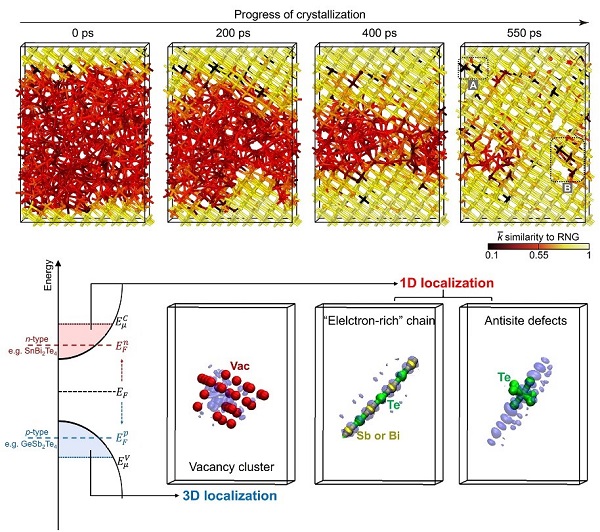XJTU researchers explore phase-change memory crystallization mechanism
Researchers from Xi'an Jiaotong University (XJTU), Sapienza University of Rome, and University of Oxford have made new progress in their study of phase-change memory crystallization mechanism.
The researchers carried out large-scale first-principles molecular dynamics calculations of nanometer size and level for GST, and observed the atomic process of rapid crystallization of GST in detail.

SOAP analysis of the crystallization process of GST and electron localization behavior in GST homogeneous crystals
A quantitative index of crystallinity was developed based on the "atomic position overlap" SOAP method, which revealed the random distribution behavior of vacancies and the formation mechanism of anti-site defects during recrystallization.
Based on the results of GST recrystallization calculations, the researchers summarized three key Anderson localization behaviors, namely quasi-three-dimensional electron localization caused by vacancy aggregation, quasi-one-dimensional electron localization caused by chain electron-rich structure and quasi-one-dimensional electron localization caused by antisite defects.
These electron localization behaviors determine the electrical behavior of the SET state of the GST device.
The research results were published in Advanced Materials under the title Unraveling Crystallization Mechanisms and Electronic Structure of Phase-Change Materialsby Large-Scale Ab Initio Simulations and selected as an editor's choice.
The State Key Laboratory for Mechanical Behavior of Materials is the first author unit.
Professor Zhang Wei from the Center for Alloy Innovation and Design (CAID) and associate professor Riccardo Mazzarello of the Sapienza University of Rome are the corresponding authors of the paper. The co-first authors of the paper are Xu Yazhi and Zhou Yuxing. Main collaborators include Wang Xudong, associate professor Volker L. Deringer and professor Ma En.
The core functional layer of phase-change memory based on chalcogen phase change material is Ge-Sb-Te (GST). It is regarded as one of the important material carriers for the development of neuromorphic computing technology.
The rapid crystallization ability of GST is the core of phase-change memory and neuromorphic computing technology. However, due to the complex chemical bonding mechanism of GST and the relatively random kinetic process at high temperature, there are still big challenges in the theoretical study of this phase-change process.

